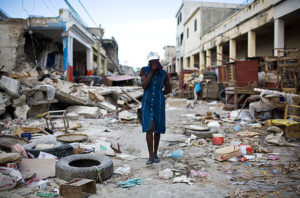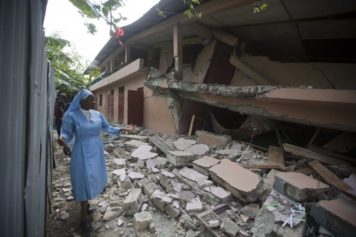Although the catastrophic physical damage to housing, roads and public buildings wrought by the Haitian earthquake on January 12, 2010, is still visible, the psychological legacy that many young earthquake survivors are still struggling to live with is less easy to see with the naked eye.
Five years since the earthquake hit the tiny Caribbean island nation of Haiti, many children there still have limited access to education, and some report exposure to exploitation and sexual violence after the already-fragile country descended into chaos in the aftermath of the disaster. Many Haitian children still show signs of emotional and psychological stress, and remain in desperate need of assistance and protection today.
Their ongoing distress, along with their hopes for a better future, is what Riccardo Venturi, World Press Photo award winner in 1997 and 2011, hoped to capture while visiting Save the Children relief programs in Haiti. Venturi’s resultant images are a humbling reminder to all involved in the rebuilding of Haiti that the international response to the disaster is far from complete.
Children who have lost one or both parents, are unaccompanied by a family member, or are still living in internally displaced persons (IDP) camps, are particularly at risk of exploitation, with sexual violence against minors in such settlements commonplace.
“I don’t feel safe here at all because people don’t respect each other. There are many cases of abuse,” said *Marie Darline, a 15-year-old girl who has been living in a sprawling Haitian IDP camp for four years.
She is one of more than 85,500 people still living in temporary accommodations following the earthquake, more than half of which are children.
“If my mother and father were alive, I would be protected. They wouldn’t let me live like this,” said Lovely*, a 14-year-old domestic worker living and working in Port-au-Prince.
Since the death of her parents in 2010, Lovely has been forced into casual domestic work in order to survive, and is frequently beaten and mistreated by her employers. Sadly, Lovely’s story mirrors that of approximately 225,000 children aged between 5 and 17 who now find themselves economically trapped into working as domestic child laborers, with little or no chance of escape from their dismal living conditions.
Lovely*, Marie*, and other children pictured in Venturi’s photo series, illustrate the fears and hopes for the future of Haitian children across the island.
“When I headed to Haiti in 2010 right after the earthquake, I saw that fear and shock were particularly evident, most of all in children,” he said.
Read More at CaribbeanNewsNow



